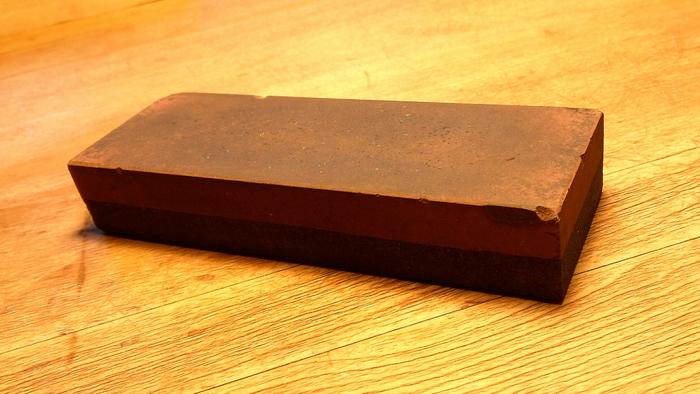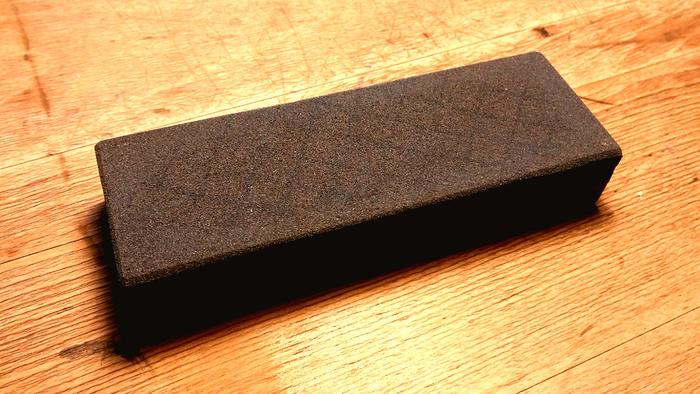Results 1 to 7 of 7
 16Likes
16Likes
Thread: Lapping super hard stone
-
02-04-2020, 01:48 PM #1Senior Member

- Join Date
- Sep 2009
- Location
- Plymouth, UK
- Posts
- 313
Thanked: 19 Lapping super hard stone
Lapping super hard stone
I found this stone in an old toolbox, and thought it might be useful either for heavy re-shaping, such as heel work, or as a lapping stone, or both.

So I gave it a soak in white spirit and then in alcohol to get the old oil and dirt out of it, and started to try lapping it. The finer side looks pretty level, the coarse side is heavily dished. So, I started the rough-out on a paving slab. Almost an hour later, I have a polished paving slab and stone which is almost where it was when I started:

Hopefully the pencil marks in the dishing in the middle are visible.
Question is, how do I level this stone?
-
02-04-2020, 02:04 PM #2

The most aggresive stuff i have found for lapping hard stones is silicon carbide grit. I beleive 60 is the lowest grit you can get. Something like this..
https://www.amazon.com/Fundamental-Rockhound-Products-Tumbling-polishing/dp/B00JTJG3GI/ref=asc_df_B00JTJG3GI/?tag=hyprod-20&linkCode=df0&hvadid=312219454312&hvpos=&hvnetw= g&hvrand=2656438450928364556&hvpone=&hvptwo=&hvqmt =&hvdev=c&hvdvcmdl=&hvlocint=&hvlocphy=9004624&hvt argid=aud-801381245258 la-493090457010&psc=1
la-493090457010&psc=1
I use it on a glass plate with some water but its been suggested to use on a metal cookie sheet which wont dish.
Other members may have better suggestions.
That looks like an India (Aluminum Oxide) / Carborundrum combo stone. I use mind to sharpen my axes.
The Silicon Carbide will definitely do the trick.
-
The Following User Says Thank You to MW76 For This Useful Post:
Montgomery (02-04-2020)
-
02-04-2020, 02:30 PM #3Senior Member

- Join Date
- Sep 2009
- Location
- Plymouth, UK
- Posts
- 313
Thanked: 19
Many thanks!
I have heard SiCa mentioned many times. It might be about time for me to get some. Over here I can only seem to find large quantities.
I have an old pot of coarse valve-grinding paste and I'm wondering if it could be pressed into service, it is an abrasive stuck together with some sort of grease. Might it be SiCa?
It is an old stone, I will go along with India/Carborundum. Seems every old workshop has a few of these lying around, and they seem to be almost indestructible.
-
02-04-2020, 02:31 PM #4Senior Member



- Join Date
- Apr 2012
- Location
- Diamond Bar, CA
- Posts
- 6,553
Thanked: 3215
Same as any other stone, 36 or 60 grit Silicone Carbide and steel cookie sheet. That is a 150 / 400 Norton combination India stone, much too course for razor work.
It does not look that much out of flat. Will be good for tools and knives.
Got Grit .com has 60 grit and 36 grit from Rock Shed Products, you don’t need much just a few teaspoons. ¼ -1/2 pound is plenty, it is inexpensive.
-
The Following User Says Thank You to Euclid440 For This Useful Post:
Montgomery (02-04-2020)
-
02-04-2020, 02:39 PM #5Senior Member



- Join Date
- Apr 2012
- Location
- Diamond Bar, CA
- Posts
- 6,553
Thanked: 3215
You can use greased valve grinding compound, it is grease and Silicone Carbide, but probably not course enough for the 150 side.
It is not expensive. The courser the grit, faster it cuts. You will feel when it stops cutting, add a bit more powder and keep the slurry wet, a thin paste, you can control the thickness by adding water and powder to what cuts best.
36 will get flat quickly. Finish with 60, once flat it goes quickly.
-
The Following User Says Thank You to Euclid440 For This Useful Post:
Montgomery (02-04-2020)
-
02-04-2020, 04:55 PM #6

I agree that it's an India combo, coarse/fine in this case. The fine side can be used for mild reshaping and heavy bevel-setting work. Once it's broken in, it becomes less aggressive. The coarse side is to coarse for razors. Better for garden tools.
Striving to be brief, I become obscure. --Horace
-
02-05-2020, 10:47 AM #7Senior Member

- Join Date
- Sep 2009
- Location
- Plymouth, UK
- Posts
- 313
Thanked: 19
Many thanks!
It fits the description of the Norton stone, this one is 6x2x1", which is one of their dimensions. I have probably had this stone for 25 years, and it was old when I got it. It will be useful for heavy re-shaping and heel work.
The valve grinding compound I have is 80 grit, so I will give it a try. Makes more sense than spending €5-10 on grit for a €15 stone, when I don't currently have any other need for SiCa grit.
The coarse side needs almost 2mm to be removed to get rid of the dishing.



 LinkBack URL
LinkBack URL About LinkBacks
About LinkBacks






 Reply With Quote
Reply With Quote
